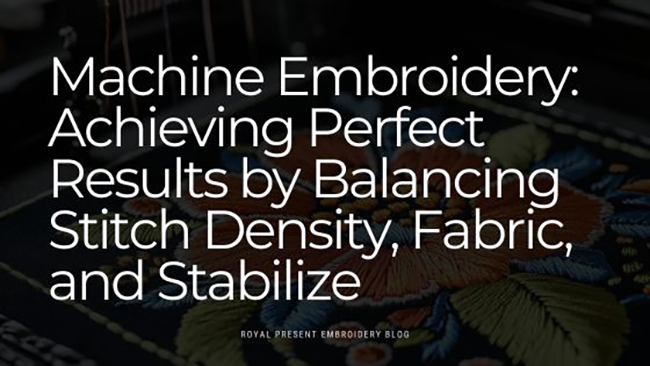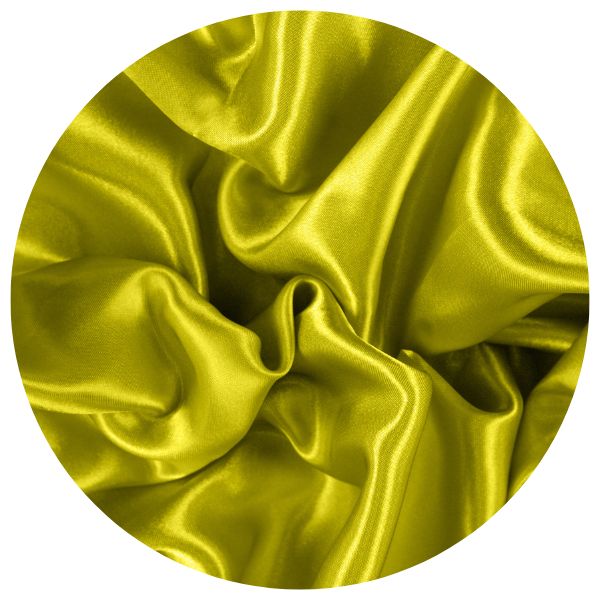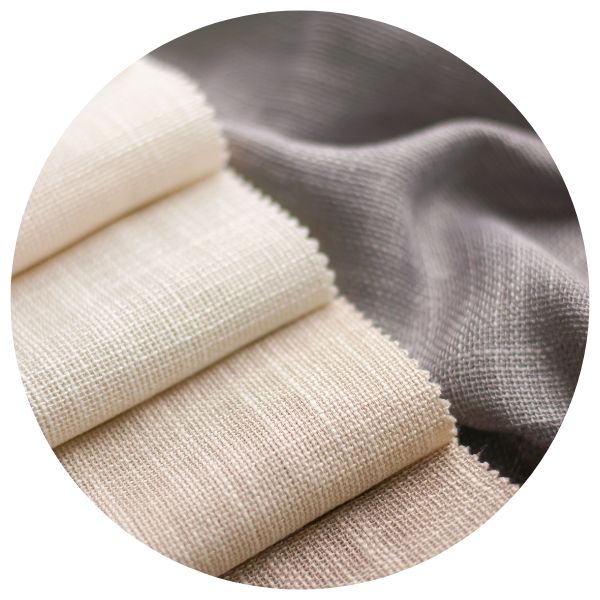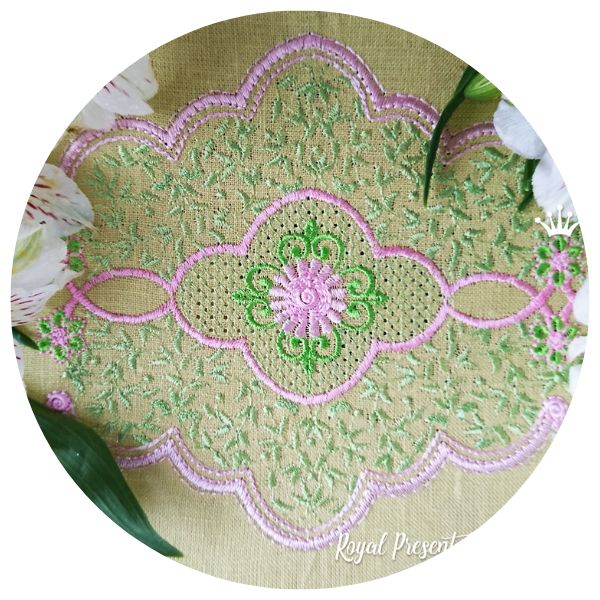
Machine Embroidery: Achieving Perfect Results by Balancing Stitch Density, Fabric, and Stabilize
Machine embroidery is an art form that requires careful selection of materials to achieve the perfect result. One crucial aspect, often overlooked, is the proper balance between stitch density, fabric type, and stabilizer. Today, we'll explore how to select the optimal stitch density for different types of fabrics and stabilizers, with specific brand recommendations and weight measurements.
What is Stitch Density and Why Does It Matter? Stitch density is measured by the number of stitches per square centimeter (or square inch). If the density is too high for the chosen fabric, it can cause puckering or stretching. To avoid these issues, it’s important to match the fabric and stabilizer properly.
Examples of Fabric and Stabilizer Pairing: Stitch Density Calculation
Lightweight Fabrics: Silk, Batiste, Organza
- Fabric Weight: 60–80 g/m² (1.77–2.36 oz/yd²)
- Recommended Stitch Density: 80–120 stitches/cm² (516–774 stitches/in²)
- Suitable Stabilizer: Water-soluble stabilizer or a soft tear-away stabilize

Silk, Batiste, Organza
Recommended Brands:
- Sulky Water Soluble Stabilizer: Weight of approximately 20 g/m² (0.59 oz/yd²), easily dissolves after the embroidery is finished.
- Madeira Avalon Plus: Water-soluble stabilizer with a weight of around 30 g/m² (0.89 oz/yd²), perfect for lightweight fabrics.
- Gunold Solvy: Ultra-thin water-soluble stabilizer ideal for delicate fabrics
Oriental Lace border in 2 sizes
Example Design: Oriental Lace border in 2 sizes
- Design Features: With a stitch density of 67 stitches/cm² (431 stitches/in²), this design can be embroidered on lightweight fabrics like silk, organza, or batiste. A lower stitch density allows the fabric to "breathe" and prevents overloading, which is essential for delicate materials.
Benefits of Lower Stitch Density on Lightweight Fabrics:
- Prevents fabric distortion and puckering.
- Makes embroidery easier, especially for thin materials prone to stretching under heavy stitching.
- Reduces the weight of the embroidery, preserving the fabric's natural softness and lightness.
Recommended Stabilizers for Such Designs:
- Sulky Solvy: Ideal for lightweight fabrics and provides stability during embroidery.
- Madeira Avalon Ultra: Water-soluble stabilizer for delicate fabrics, easy to remove after stitching.
Calculation Example:
- Design size: 100x100 mm (3.9x3.9 in), with 10,000 stitches on organza.
- Area: 100 mm × 100 mm = 10 cm² (3.9 × 3.9 in = 15.21 in²).
- Stitch density: 10,000 / 10 = 100 stitches/cm² (656 stitches/in²).
Pro Tip: Use two layers of water-soluble stabilizers for more complex designs to prevent fabric shifting and distortion during embroidery.
- Sulky Water Soluble Stabilizer: Weight of approximately 20 g/m² (0.59 oz/yd²), easily dissolves after the embroidery is finished.
- Madeira Avalon Plus: Water-soluble stabilizer with a weight of around 30 g/m² (0.89 oz/yd²), perfect for lightweight fabrics.
- Gunold Solvy: Ultra-thin water-soluble stabilizer ideal for delicate fabrics.
- Design Features: With a stitch density of 67 stitches/cm² (431 stitches/in²), this design can be embroidered on lightweight fabrics like silk, organza, or batiste. A lower stitch density allows the fabric to "breathe" and prevents overloading, which is essential for delicate materials.
- Prevents fabric distortion and puckering.
- Makes embroidery easier, especially for thin materials prone to stretching under heavy stitching.
- Reduces the weight of the embroidery, preserving the fabric's natural softness and lightness.
- Sulky Solvy: Ideal for lightweight fabrics and provides stability during embroidery.
- Madeira Avalon Ultra: Water-soluble stabilizer for delicate fabrics, easy to remove after stitching.
- Design size: 100x100 mm (3.9x3.9 in), with 10,000 stitches on organza.
- Area: 100 mm × 100 mm = 10 cm² (3.9 × 3.9 in = 15.21 in²).
- Stitch density: 10,000 / 10 = 100 stitches/cm² (656 stitches/in²).

Lilen Fabric
Medium-Weight Fabrics: Cotton, Linen
- Fabric Weight: 140–180 g/m² (4.13–5.31 oz/yd²)
- Recommended Stitch Density: 150–230 stitches/cm² (968–1,484 stitches/in²)
- Suitable Stabilizer: Medium-weight tear-away or water-soluble stabilizer.
Recommended Brands:
- Pellon Stitch-N-Tear: Tear-away stabilizer weighing about 50 g/m² (1.48 oz/yd²), ideal for cotton and linen.
- Sulky Tear Easy: Tear-away stabilizer, weight around 60 g/m² (1.77 oz/yd²), a good choice for medium-weight fabrics.
- OESD Heavyweight CutAway: Stabilizer with a weight of about 80 g/m² (2.36 oz/yd²), suited for heavier designs on medium fabrics.
Nutcracker in the Fir Branches - 3 sizes
Calculation Example:
- Design size: 130x130 mm (5.1x5.1 in), with 33,000 stitches on linen.
- Area: 130 mm × 130 mm = 16.9 cm² (5.1 × 5.1 in = 26 in²).
- Stitch density: 33,000 / 16.9 ≈ 195 stitches/cm² (1,258 stitches/in²)
Pro Tip: When embroidering on loosely woven linen or cotton, use stabilizers both under and over the fabric. The top layer helps prevent fabric fibers from pulling and stitches from sinking into the fabric.
Design Example: The "Nutcracker in the Fir Branches" design has a stitch density of about 218 stitches/cm² (1,405 stitches/in²), making it moderately dense. Such designs are best embroidered on fabrics like linen, canvas, or heavy cotton, which can withstand higher stitch densities without distortion.
Heavyweight Fabrics: Denim, Canvas, Felt
- Fabric Weight: 250–350 g/m² (7.38–10.33 oz/yd²)
- Recommended Stitch Density: 250–300 stitches/cm² (1,613–1,935 stitches/in²)
- Suitable Stabilizer: Heavy adhesive stabilizer or tear-away stabilizer for sturdy fabrics.
Recommended Brands:
- Floriani No Show Mesh: Adhesive stabilizer weighing around 100 g/m² (2.95 oz/yd²), perfect for embroidery on heavy fabrics like denim.
- Gunold CutAway Plus: Stabilizer with a weight of about 120 g/m² (3.54 oz/yd²), holds heavy fabrics and complex designs well.
- Sulky Cut-Away Soft n' Sheer: Medium-weight stabilizer with a weight of 90 g/m² (2.66 oz/yd²), suitable for dense embroidery on heavy fabrics.
American Eagle with USA flags - 2 sizes
Example Design: American Eagle with USA flags mschine embroidery design
Calculation Example:
- Design size: 178x230.9 mm (7x9 in) on denim, with 98,300 stitches.
- Area: 178 mm × 230.9 mm = 411 cm² (7 × 9 in = 63 in²).
- Stitch density: 98,300 / 411 ≈ 239 stitches/cm² (1,542 stitches/in²).
Pro Tip: For denim or other heavy fabrics, use adhesive stabilizers to prevent shifting and puckering. Ensure the fabric is ironed to allow the stabilizer to adhere properly and hold the fabric during embroidery.
Key Facts and Tips
-
Layered Stabilizers: For especially dense or intricate designs, use two layers of stabilizers: one adhesive or tear-away layer for support and another water-soluble layer for easy removal after work.
-
Thread Type: In addition to stitch density and fabric, consider the type of thread used. Metallic threads, for instance, require a lower stitch density to avoid fabric distortion and embroidery damage.
-
Proper Fabric Hooping: When working with lightweight fabrics, avoid over-tightening them in the hoop. This can lead to fabric distortion after embroidery. A light stabilizer should support the fabric without excessive tension.
-
Test Before Starting: Always do a test stitch on a small piece of fabric with the same stabilizer to avoid issues on the final product.
Conclusion Stitch density, fabric type, and stabilizer are key elements of successful machine embroidery. Each fabric type requires a tailored approach, and the right stabilizer ensures that the fabric maintains its shape, leading to high-quality embroidery. By following these recommendations, you can achieve perfect embroidery results without puckering or distortion.

Author: Ludmila Konovalova
My name is Ludmila Konovalova, and I lead Royal Present Embroidery. Embroidery for me is more than a profession; it is a legacy of my Ukrainian and Bulgarian heritage, where every woman in my family was a virtuoso in cross-stitch and smooth stitching. This art, passed down through generations, is part of my soul and a symbol of national pride.
Date: 21.10.2024





 Get Sign-In Link
Get Sign-In Link Login with Google
Login with Google Login with Facebook
Login with Facebook Login with Amazon
Login with Amazon Login with Paypal
Login with Paypal